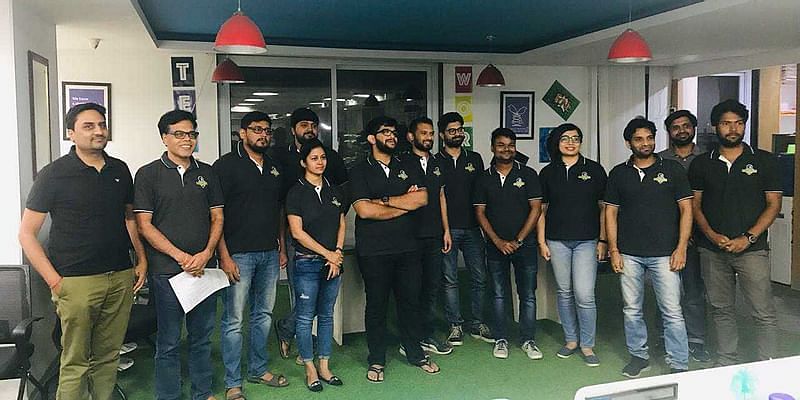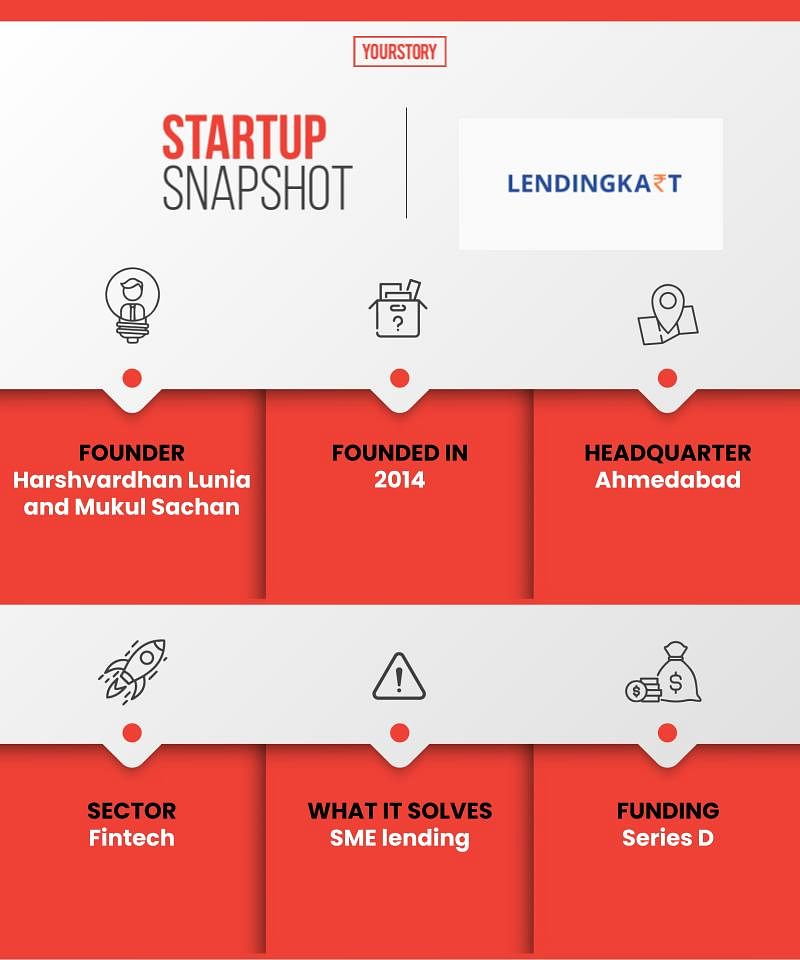For Harshvardhan Lunia, small and medium businesses have always been a part of everyday life, as his father owned a business in Ahmedabad. However, in 2014, he felt a lag in the market. As he noticed businesses and SMEs around his hometown being run by a younger and more digital generation, he realised that this new generation was also looking for newer ways to run their businesses and procure loans. Harsh and friend Mukul Sachan felt that the existing financial models were simply inadequate.
Harsh, who had a cushy job at ICICI’s corporate office in London, says that India’s retail segment is run by SMEs, and they are the most underrepresented segment.
Harsh soon launched Lendingkart, a fintech startup that provides working capital loans to SMEs and MSMEs. He says he realised that most of the SMEs in India do not have the capital and resources, and have a huge market need for working capital. Traditional banks and NBFCs weren’t the best option, as they look at the borrower with the lens of someone who could possibly default.
“There needs to be an understanding of the market and how these businesses work. Most of these SMEs are family run, their way of running a business and making money is very different from a regular corporate,” says Harsh.
There clearly is some truth in this belief as by 2019, the team reported only 38 frauds. Harsh explains that the mentality of most of the Indians is different, especially those running SMEs. “They need to run their day-to-day operations smoothly, defaulting just isn’t an option for them,” added Harsh.

COVID-19 as an accelerant
However, 2020 and COVID-19 has been an accelerant for a business like LendingKart. “The initial days of the pandemic was really hard on SMEs. With the lockdown and confusion, many had lost businesses severely. However, soon they all realised the need to go digital and have a strong digital presence. The need for loans had increased significantly as well,” explains Harsh.
In FY20 alone, the startup had disbursed 53,000 loans. The company said this was an 83 percent increase over the last year. It has successfully extended its support to over 90,000 small business across 1300 cities and towns from 2015 to now.
The startup also raised Rs 319 crore equity in Series D funding during the pandemic.
Speaking of their investment and what they saw in the team, Pankaj Makkar, Managing Director/Head Bertelsmann India Investments says,
“In my view, Lendingkart today continues to be one of the most innovative companies in the SME lending space. For us, the SME lending space means the $1 billion working capital loan market, and if you look at the larger NBFCs and banks that cater to it, it is a $60 billion to $65 billion market.”
He adds, “The small loans market of a few lakhs has not been cracked efficiently by the banks, because the cost of the physical infrastructure of setting up a branch becomes unreliable. We understood that if an SME market had to be catered to, it had to be done so by an online player. When we met Harsh and the team, they showed a clear understanding of the market, its needs and the space.”

The growing SME space
The MSME sector is growing at a faster rate, with its consequent contribution to India’s GDP. According to the Confederation of Indian Industry (CII), MSMEs contribute 6.11 percent to the manufacturing GDP, 24.63 percent to the GDP from service activities, and 33.4 percent to India’s manufacturing output. Despite its huge contribution, the sector is considered laid back.
There are others in the space, like NeoGrowth, Vivriti Capital, Shubh Loans, Happy Loans, etc. The other players in the SME space include – Khatabook and OkCredit.
Pankaj says what also helped was that the team’s primary focus was the segment. “Most other players we had interacted with were looking at multiple segments of use cases – the consumer sector, SMEs, individuals etc. But we felt the SME segment was large enough and needed a lot of focus and innovation, which Lendingkart displayed from day one,” he adds.
Understanding the user
What Lendingkart does is ensure that there is an availability of credit for SMEs and MSMEs that are capital deficient or don’t have access to credit.
“It is a highly unorganised space and segment. Thus, the work begins with first understanding the space and the market. In the initial days, we spent most of our time talking to the customer, understanding what they want and fine-tuning our product offerings accordingly,” says Harsh.
The way they could do that was by leveraging technological tools built on big data analytics and machine learning algorithms to evaluate creditworthiness. “For that, you need to look at not just the basic balance sheet, but things like the daily business and operations over a period of time,” says Harsh.
The platform focusses on analysing thousands of data points to assess factors like financial health, comparative market performance, social reliability and compliance, and a distinctive evaluation process.
With evolving business models and uncertainty, traditional data sources are no longer sufficient for comprehensive risk assessment of MSME and retail customers. Lendingkart has taken this challenge as an opportunity to simulate these factors and multiple scenarios in the underwriting model that will be updated in line with growth and changes in the ecosystem.
“At Lendingkart, we have identified various proxies that can help determine the business’s financial health. We have a simple application process which requires only the bank statement and GST/ tax returns of the business as documentation,” says Harsh.
Building a robust tech product
The platform goes into customer-centric technology enabled credit risk assessment methodology that enables a deeper understanding of business cash flows and financing requirements. The initial credit underwriting model determining an accept / reject decision was evolving to a rule-based one as the self-learning algorithmic model built with more data points was becoming available.
Presently, Lendingkart credit model has the ability to classify an application into various risk categories, and objectively determine the amount eligibility based on the SME’s risk profile. The prediction of amount eligibility has resulted in disbursal allocation to eligible customers over time.
Lendingkart also assists small businesses by creating awareness of the customised product in the borrower’s native Indian language. Signing and verification of documents have been simplified by services like e-Aadhaar and digital signing, thus enabling lending across the country.
This has also significantly reduced the time taken to process loan applications, that historically involved branch visits at every step of the application, including moving towards paperless processing of applications and flexible digital payment options.
Lending together
Lendingkart has further launched a SaaS based co-lending platform called “Lendingkart 2gthr” to financial partners who want to maximise their financial products reach related to MSMEs.
The co-lending platform “Lendingkart 2gthr” is a suite of tools that provides capabilities to achieve the following goals:
- The onboarding of a partner should be in record time by configurable, plug and play modules.
-
Automating and enabling real time multi party workflow, approvals and pendency resolution.
- Seamless customer engagement
For the first co-lending partner, an offline integration approach was taken as it was one of a kind association in the industry, and there are no custom-built products for this association.
“Today, within a year of the offline pilot project, five partners have been onboarded and all of them have been integrated digitally and seamlessly with real time information sharing, verification and approval workflow. These partnerships are contributing to approximately 18 percent of disbursed applications,” explains Manish Bhatia, President of Technology, Analytics and Capabilities.
For the first partner, the pilot was undertaken in a phygital format (the concept of using technology to bridge the digital world with the physical world) to identify the key features required for MVP, insights and learnings. A project team of five people from Product, Technology and operations team brainstormed with the pilot programme outcomes to come up with the first version of the product, which was built in three months.
“The priority was to provide a seamless interface to our partners so that they can process the loan application on their end in real time, and consequently this efficiency and reduced action time benefit will be passed on to our customers who will have loan product offer as per approved terms in record time,” explains Manish.
Talking about their future plans, Harsh says the team is looking to expand the company’s lending base, and further reach out to small and undeserved SMEs, and also strengthen the company’s technological and analytical capability.
“The pandemic has proven the importance of SMEs and how they actually can help the country’s economic growth. Our focus will remain towards helping these companies evolve and grow,” adds Harsh.



